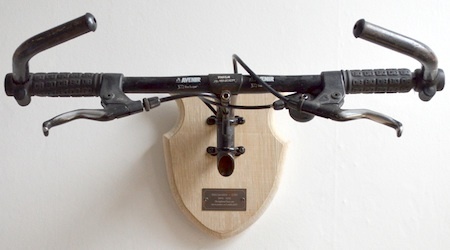Marc Abrahams's Blog, page 241
November 7, 2016
Can you tell, by looking at this photo, whether this scientist is dead?
A medical study that says people can predict whether someone is dead merely by looking at a photo of that person has itself been killed. The journal that had published the article has now retracted it. The Retraction Watch blog explains:
Some people can look at an old photograph of a person — say, of your grandmother in elementary school — and tell whether the person is today alive or dead, according to a paper published last spring.
If that sounds too weird to be true…well, it might be. The journal editors have retracted the paper for not having enough evidence to back up its claims, despite the authors’ objections.
Here’s the retraction notice for “Prediction of Mortality Based on Facial Characteristics,” published in Frontiers in Human Neuroscience: “The journal retracts the 17 May 2016 article cited above. Following publication, concerns were raised regarding the scientific validity of the article. The Chief Editors subsequently concluded that aspects of the paper’s findings and assertions were not sufficiently matched by the level of verifiable evidence presented. The retraction of the article was approved by the Chief Editors of Human Neuroscience and the Editor-in-Chief of Frontiers. The authors do not agree to the retraction.”
Researchers Arnaud Delorme, Alan Pierce, Leena Michel and Dean Radin, describe, in the study, what they wish you, the reader, to know:
Participants examined 404 photographs displayed on a computer monitor, one photo at a time, each shown for a maximum of 8 s. Half of the individuals in the photos were deceased, and half were alive at the time the experiment was conducted. Participants were asked to press a button if they thought the person in a photo was living or deceased. Overall mean accuracy on this task was 53.8%, where 50% was expected by chance.
Here is a photograph of study co-author Dean Radin. Can you tell, by looking at this photo, whether he is dead or alive?
Co-authors Radin, Delorme, and Michel earlier published a perhaps immortal, perhaps not-yet-retracted study called “Electrocortical activity associated with subjective communication with the deceased,” which we savored here a while ago.

Crafting a “six-pack” from excess body fat
“Currently we are experiencing a ‘golden age’ of plastic surgery body contouring with new innovations by thought leaders, including fat grafting, which are completely raising the bar of postoperative results that can now be delivered to the patients in terms of appearing youthful and sculpted yet natural.”
Today, for example, it’s possible to create (apparent) abdominal muscle enhancements by collecting excess fat from one or more parts of the body and then re-injecting it to form a fat-filled ‘six-pack’ (effect).
“
The fat is collected and processed. The fat is drained using a metal strainer and then placed into 20 cc syringes for reinjection. The patient is then rotated back into a supine position. The abdominal area is re-prepped, draped, and re-marked for injection. Average volumes removed from each surgical site to obtain fat and highlight contour are as follows: lower abdomen, 272 cc; muscular inscriptions, 136 cc; lateral anterior abdomen, 313 cc; bilateral flanks, 537 cc; and upper back, 228 cc. Average volumes of fat placed into each area are as follows: lower ‘six pack,’ 42 cc each; middle ‘six pack,’ 58 cc each; upper ‘six pack,’ 55 cc each; and serratus muscle, 31 cc each. The liposuction sites are closed with 5-0 black nylon to prevent egress of injected fat. Lower pelvic incisions remain open for drainage.”
See: Utilizing the Power of Fat Grafting to Obtain a Naturally-Appearing Muscular “6-Pack” Abdomen
– by Douglas S. Steinbrech, MD; and Sammy Sinno, MD, in the Aesthetic Surgery Journal, Volume 36, Issue 9, (2016) pp. 1085 – 1088
Also see: Dr Solomon’s (new) buttock augmentation method.

November 6, 2016
The Ig Nobel book is now out in Traditional Chinese
And now, the traditional Chinese translation that you may have been waiting for: The Ig Nobel Prizes, by Marc Abrahams, ISBN 9789869189781.

Time Travel and Journal Publishing
Can journal publishers travel backwards in time? You may think the answer is no, but consider the following case.
Along with Ginestra Bianconi of Queen Mary University of London, I edited a special issue of European Journal of Applied Mathematics on “Network Analysis and Modelling.”
To introduce the special issue, Ginestra and I wrote an editorial. As you can see from this screenshot, our editorial involved a very speedy review process (perhaps including time travel). It helped, of course, that we did know that the editorial for our invited special issue was going to be accepted.

This editorial was accepted even before it was received. (“Received 13 July 2016; accepted 12 July 2016”) The journal was fast!
P.S. No actual time travel occurred in this adventure (as far as we know). :)

November 5, 2016
Hats Off, or On, From a Medical Perspective
Are there hat-wearing patterns in spectators who attended baseball games — patterns that might be discernible over a ten-year period, patterns that might be exploitable? This study claims to begin to answer those questions.
“Hat-wearing Patterns in Spectators Attending Baseball Games: a 10-Year Retrospective Comparison,” Aaron S. Farberg, Stephen Donohue, and Darrell S. Rigel, Cutis, vol. 98, no. 3, September 2016, pp. 181-184. (Thanks to Ivan Oransky for bringing this to our attention.) The authors, at the Icahn School of Medicine at Mount Sinai, the New York Yankees baseball team, and New York University School of Medicine, explain:
“Spectators at baseball games may receive a considerable amount of exposure to solar UV radiation (UVR). The purpose of this study was to evaluate if public education about sun protection over the last 10 years has impacted the use of hats at Major League Baseball (MLB) games. Photographs of seating sections during a 3-game series in New York, New York, were obtained and analyzed to evaluate the percentage of spectators wearing hats. Different seating sections were evaluated (sunny, shaded, bleachers) and assessed as well as compared to similar data reported 10 years prior. Given the limited change in hat use over the last decade, a knowledge and behavioral gap exists that may be exploitable to achieve better skin cancer prevention.”
Here’s some data from the study:

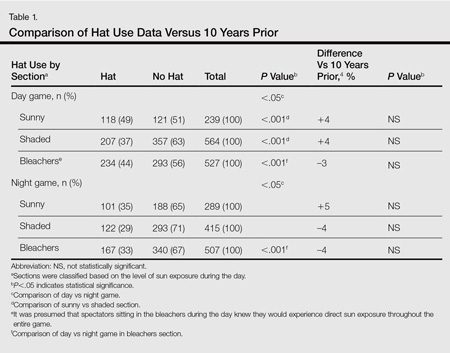
Here’s video of co-author Donahue in the training room at Yankee Stadium, promoting an unrelated medical technology product:

Bicycle Taxidermy
The Bicycle Taxidermy blog documents taxidermy’d bicycle remains:
Crafted in London; the taxidermy service mounts a client’s steed on a scorched or bleached European oak plaque made by Mick, a local joiner. Chrome mounting brackets fix the stem above a stainless steel epitaph etched in Argyll, Scotland, the plaque denotes the horned beasts model, pet name, dates ridden and a commemorative verse. Just fill in the epitaph field on the site and I’ll get it engraved and send out the plaque for you to mount yourself.
Here is one of the many trophies displayed there:
SPECIALIZED – DIAMONDBACK [1994-2012]. ‘The Highland beast, put out to pasture on London fields’:
Will Coldwell explored and explained the collection, for The Guardian.
[via Things Magazine]
BONUS: Video of a bicycle / ice-skate hybrid:

November 4, 2016
Report of the scientific investigation: Can farts be lit on fire by a laser?
There was indeed a scientific investigation after the (widely reported) fire that ignited during a patient’s cervical conization procedure at the University of Tokyo Hospital, causing “a wide range of burns [to the] thighs [and] rear” to the patient. That scientific report is lavishly illustrated with photographs.
To determine whether the accident could have been caused by an ill-timed fart from the patient combined with a high power laser — rather than negligence by the doctors or equipment failure — researchers conducted tests, then issued a report.
After reviewing the surgery video and testimony of the surgeon, it was clear that the fire did not start on any coverings or drapes the patient had on, nor on any alcohol based antiseptic. This left but one option for the researchers: recreate the conditions using a “test doll”, laser, and bucket of lean beef with intestinal gasses.
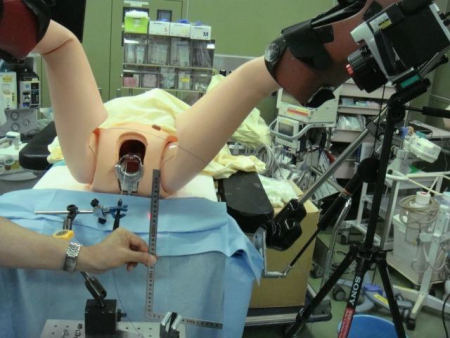
Seen here, the test doll and laser
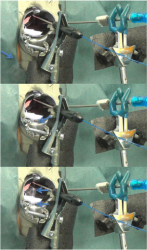 A potential problem with the fart lighting hypothesis was figuring out how the fart could have gotten to the vaginal area, since intestinal gases are released by the butt, located on the opposite side of the surgical field. The scientists set up the test doll in a position to replicate the event, and used a test gas to track the direction the fart may have flowed in. By following smoke fumes fed through a tube, as seen in the pictures here starting from the top going down, it could be shown that gasses emitted from the rear could get sucked up towards the vagina. It is thought that this trapped intestinal gas (the patient’s fart) could begin the combustion process once the energy from the laser interacted with the flesh and gas.
A potential problem with the fart lighting hypothesis was figuring out how the fart could have gotten to the vaginal area, since intestinal gases are released by the butt, located on the opposite side of the surgical field. The scientists set up the test doll in a position to replicate the event, and used a test gas to track the direction the fart may have flowed in. By following smoke fumes fed through a tube, as seen in the pictures here starting from the top going down, it could be shown that gasses emitted from the rear could get sucked up towards the vagina. It is thought that this trapped intestinal gas (the patient’s fart) could begin the combustion process once the energy from the laser interacted with the flesh and gas.
To add even more fiber to the experiment, the researchers took lean beef, placed the lean beef in a bucket, and filled that bucket with intestinal gasses of various concentrations. By firing a laser at the lean beef, a very small explosion could ignite the experimental farts, as shown below.

The researches conclude that: (1) farts can be lit on fire by using a laser, and that (2) those farts could possibly be lit on fire if those farts are sucked into a vagina while a laser is aimed at that vagina.
BONUS: A music video that perhaps expresses the doctors’ reaction when the incident occurred:
“We Didn’t Start The Fire”, by Billy Joel:
BONUS (distantly related topic): Someone’s video explanation of a different way to light a fart (using a lighter):
BONUS (extension of that distantly related topic): Fart lighting compilation:

November 3, 2016
A randomness as to which of a scientist’s publications will have the most oomph
 Despite common belief (and some earlier research on the question) that success tends to come early for scientists, a scientist’s single most successful publication is likely to occur at any point in the sequence of papers that she or he publishes. That’s the gist of a new study.
Despite common belief (and some earlier research on the question) that success tends to come early for scientists, a scientist’s single most successful publication is likely to occur at any point in the sequence of papers that she or he publishes. That’s the gist of a new study.
The study explains that people in general tend to produce more papers and everything else early in their careers, which gives the misleading appearance that their first papers are most likely to be the most successful.
The study is “Quantifying the evolution of individual scientific impact,” by Roberta Sinatra [pictured here], Dashun Wang, Pierre Deville, Chaoming Song, and Albert-László Barabási, published in Science [04 Nov 2016: Vol. 354, Issue 6312].
The scientists also prepared a vivid set of visualizations, which they put online.
And Nature magazine prepared a video that explains it all:
(Thanks to Andrea Rapisarda, who won an Ig Nobel Prize for his own randomness research, for bringing this to our attention.)

A randomness to which of a scientist’s publications will have the most oomph
 Despite common belief (and some earlier research on the question) that success tends to come early for scientists, a scientist’s single most successful publication is likely to occur at any point in the sequence of papers that she or he publishes. That’s the gist of a new study.
Despite common belief (and some earlier research on the question) that success tends to come early for scientists, a scientist’s single most successful publication is likely to occur at any point in the sequence of papers that she or he publishes. That’s the gist of a new study.
The study explains that people in general tend to produce more papers and everything else early in their careers, which gives the misleading appearance that their first papers are most likely to be the most successful.
The study is “Quantifying the evolution of individual scientific impact,” by Roberta Sinatra [pictured here], Dashun Wang, Pierre Deville, Chaoming Song, and Albert-László Barabási, published in Science [04 Nov 2016: Vol. 354, Issue 6312].
The scientists also prepared a vivid set of visualizations, which they put online.
And Nature magazine prepared a video that explains it all:
(Thanks to Andrea Rapisarda, who won an Ig Nobel Prize for his own randomness research, for bringing this to our attention.)

Dr Solomon’s (new) buttock augmentation method
George Solomon, MD of the Solomon Cosmetic Center, Palm Harbor, FL, USA, writes (in the American Journal of Cosmetic Surgery, September 2016) about Buttock Augmentation : A Novel Alternative to a Lengthy Procedure. He points out that despite the number of fat-transfer procedures being performed worldwide, there is no standardization for the harvesting or transferring of the fat – it’s often a two-part process whereby the removed fat is stored temporarily before being re-injected. His new process removes fat from one location and transfers it to another (in this case the buttocks) in one streamlined automated procedure. How does it work?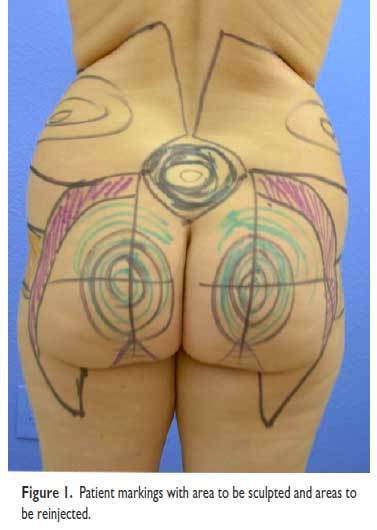
“The technique described in this article is fully automated. The fat is collected in a closed sterile canister. The canister sits on top of a vibrating plate which allows the fat to sediment. Then it passes through sterile tubing to the vibrating cannula to the patient. The fat is not exposed to air and is not manually handled. Therefore, the risk of desiccation and infection is minimal. In addition, the amount of supplies and staff needed is minimal. This procedure also provides less time and less fatigue on the surgeon.”
Also see: Gluteal Aesthetic Unit Classification
Coming soon: Crafting a “six-pack” from excess body fat.

Marc Abrahams's Blog
- Marc Abrahams's profile
- 14 followers




